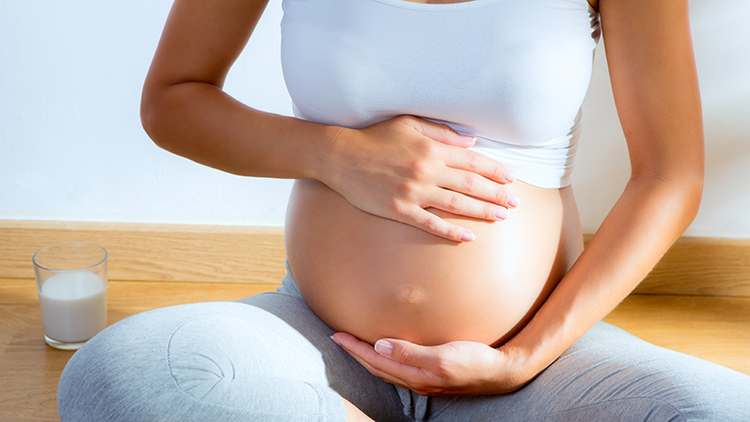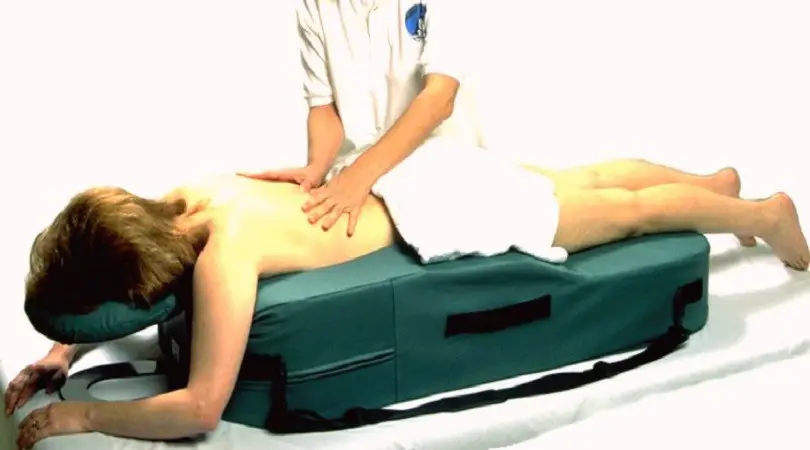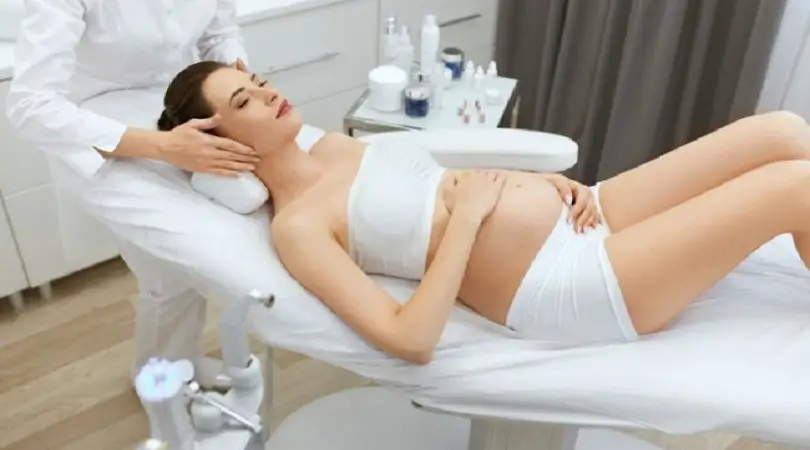Last Updated on January 6, 2025
Yes, pregnant women can lay on their stomach for a massage. It is generally safe and comfortable, especially in the first trimester of pregnancy.
During pregnancy, the body goes through significant changes which can make certain positions uncomfortable for massage. However, laying on the stomach is typically safe during the first trimester when the belly isn’t too big. In the later stages of pregnancy, it may become uncomfortable or even unsafe for the mother and the baby.
It is important to communicate with your massage therapist about your pregnancy and any concerns you may have. They will be able to provide a safe and comfortable position for you during the massage, such as using special cushions or pillows to support your growing belly.

Credit: www.gotknots.ca
Related: Can You Play Tennis While Pregnant?
The Safety Of Stomach Massage During Pregnancy
During pregnancy, many women experience discomfort and aches in their bodies. Massage therapy can be a great way to alleviate these symptoms and promote relaxation. However, one common question expectant mothers often ask is whether it is safe to lay on their stomach during a massage.
In this section, we will explore the safety concerns surrounding stomach massage during pregnancy and why it is generally not recommended.
Benefits Of Massage During Pregnancy
Before discussing the safety concerns of stomach massage during pregnancy, let’s first take a look at the benefits of massage for expectant mothers:
- Relieves muscle tension: Pregnancy can put significant strain on your muscles and cause discomfort. Massage can help relax your muscles and relieve tension, making you feel more comfortable.
- Reduces swelling: Swelling in the legs and feet is a common issue during pregnancy. Massage techniques such as lymphatic drainage can help reduce swelling by improving circulation.
- Eases back pain: As your baby grows, your center of gravity shifts, putting extra pressure on your back. Massage therapy can help alleviate back pain and promote better posture.
- Reduces anxiety and stress: Pregnancy can be an emotional rollercoaster, and massage can provide a much-needed escape from the stress and anxiety that may accompany it.
- Improves sleep quality: Hormonal changes and physical discomfort can make it difficult to get a good night’s sleep during pregnancy. Massage can help you relax and improve sleep quality.
Why Laying On The Stomach Is Generally Not Recommended
As your pregnancy progresses, your body goes through various changes to accommodate your growing baby. One of these changes is the forward shift of your center of gravity, which puts pressure on your abdomen when you lie on your stomach.
Laying on your stomach can lead to discomfort and potential harm to both you and your baby. Here are some reasons why laying on the stomach is generally not recommended during pregnancy:
- Increased pressure on the uterus: Lying on your stomach places direct pressure on your uterus, potentially causing discomfort and reducing blood flow to the baby.
- Strain on the ligaments: The ligaments supporting your uterus may become stretched and strained as your baby grows. Laying on your stomach can exacerbate this strain and potentially lead to ligament damage.
- Difficulty in breathing: As your uterus expands, it can press against your diaphragm, making it harder to breathe when lying on your stomach.
- Risk of dizziness or fainting: The pressure on your abdomen can also affect your blood pressure, potentially leading to dizziness or fainting.
Safety Concerns Of Stomach Massage During Pregnancy
While massage therapy can be beneficial during pregnancy, stomach massage should generally be avoided due to the safety concerns mentioned above. However, there are safe alternatives that can still provide relief and relaxation:
- Side-lying position: Many massage therapists are trained in techniques that allow you to comfortably lie on your side during a massage. This position relieves pressure on your abdomen while still targeting areas that need attention.
- Back and shoulder massage: Focusing on the back and shoulder areas can help alleviate discomfort without the need for stomach massage.
- Prenatal massage pillows: Specially designed pillows can be used to support your body during a massage, allowing you to lie comfortably on your back or side while still receiving the benefits of massage therapy.
It’s crucial to communicate openly with your massage therapist about your pregnancy and any concerns you may have. A qualified and experienced therapist will be able to modify their techniques and positions to ensure your safety and comfort throughout the session.
Remember, the goal of massage during pregnancy is to provide relaxation and relief, so it’s important to prioritize your well-being and choose techniques that are safe for you and your baby.
Alternative Positions For Comfortable Massage
During pregnancy, lying on the stomach for a massage may not be the most comfortable position for many women. As the baby grows, lying on the stomach can put pressure on the abdomen and cause discomfort. However, there are alternative positions that can provide a comfortable and relaxing massage experience for pregnant clients.
Importance Of Comfortable Positioning During Pregnancy Massage
When it comes to pregnancy massage, comfort is key. Finding the right position allows the expecting mother to fully relax and enjoy the benefits of the massage. It also ensures that the therapist can effectively address any areas of tension or discomfort.
Here are a few reasons why comfortable positioning is crucial during a pregnancy massage:
- Comfort promotes relaxation: Pregnancy can bring its fair share of physical and emotional stress. By providing a comfortable position, the massage allows the mother-to-be to unwind and fully embrace the relaxation benefits of the treatment.
- Proper alignment and support: Choosing the right position helps maintain proper alignment of the body, ensuring that the baby and the mother’s body are adequately supported. This is especially important as the pregnancy progresses and the body undergoes various changes.
- Enhanced circulation and lymphatic flow: Proper positioning during massage can promote optimal blood and lymphatic flow. This can help reduce swelling, promote toxin elimination, and support overall health during pregnancy.
Recommended Positions For Pregnant Clients
When it comes to massage positions for pregnant clients, certain alternatives are more popular and comfortable than lying on the stomach. Here are some recommended positions that can provide a safe and comfortable massage experience:
- Lateral position: This position involves lying on the side with pillows strategically placed for support. The expecting mother can lie on either side depending on her preference while ensuring proper alignment of the spine. Pillows can be used to support the growing belly and provide additional comfort.
- Semi-reclining position: A semi-reclining position allows the client to lie back slightly while maintaining support for the head, neck, and back. This position can be achieved using an adjustable massage table or with the help of extra pillows.
- Seated position: For shorter massage sessions or when certain areas need focused attention, a seated position can be an excellent alternative. The client can sit on a specially designed chair, providing support and comfort for the duration of the massage.
Remember, the positions may vary depending on the specific needs of the client and the stages of pregnancy. It is always best to consult with a trained prenatal massage therapist who can adjust positions and techniques to ensure a safe and comfortable experience.
By considering alternative positions, pregnant clients can still enjoy all the benefits of a soothing massage, with the added bonus of keeping both baby and mom-to-be comfortable.
Related: Can You Take Gaviscon While Pregnant?
Modifications For Stomach Massage During Pregnancy
Special Considerations For Stomach Massage During Pregnancy:
During pregnancy, there are certain special considerations that should be taken into account when it comes to stomach massage. It’s important to prioritize the safety and comfort of the expectant mother to ensure a positive experience. Here are some key points to keep in mind:
- The first trimester: It’s generally advised to avoid stomach massage during the first trimester, as this is a crucial period of development for the baby. Gentle techniques like light stroking or circular motions can be used instead.
- The second and third trimesters: As the pregnancy progresses, modifications to the traditional stomach massage position are necessary. The mother should no longer lay flat on her stomach due to the pressure it can place on the uterus and the baby. Instead, a side-lying position with proper support and padding is recommended.
- Comfort and relaxation: It’s crucial to prioritize the comfort of the expectant mother during the massage session. The mother may experience heightened sensitivity or tenderness in certain areas, so it’s important to check in regularly and adjust the pressure accordingly.
How To Properly Support The Belly During Massage:
Proper support of the belly is essential to ensure the mother’s comfort and safety during a stomach massage. Here are some techniques to achieve this:
- Side-lying position: The expectant mother should be comfortably positioned on her side, placing a pillow or bolster between her knees for support and to maintain proper spinal alignment.
- Belly support: To relieve pressure on the belly, a specially designed pregnancy pillow can be used. This pillow provides support and allows the belly to rest comfortably without any strain or discomfort.
Techniques To Relieve Pressure On The Stomach:
When performing a stomach massage on a pregnant woman, it’s important to use techniques that relieve pressure on the stomach area. Here are some techniques to consider:
- Light touch: Instead of deep-pressure massage techniques, opt for light touch and gentle strokes to ensure the comfort of the expectant mother.
- Side-lying positions: By positioning the mother on her side during the massage, the pressure on the stomach is minimized, allowing for a more relaxed and comfortable experience.
- Focus on other areas: During the massage session, focus on other areas of the body, such as the back, shoulders, and legs, to provide relaxation and relieve tension without overstimulating the stomach area.
- Communication is key: Every pregnancy is unique, and what feels comfortable for one woman may not be the same for another. It’s crucial to encourage open communication between the massage therapist and the expectant mother to ensure that the techniques used are tailored to her needs and preferences.
Remember, when it comes to stomach massage during pregnancy, safety and comfort are of utmost importance. By following the special considerations, providing proper support for the belly, and using techniques that relieve pressure on the stomach, a massage therapist can offer a relaxing and beneficial experience for the expectant mother.
Communication With Your Massage Therapist
Importance Of Open Communication With Your Massage Therapist
When it comes to receiving a massage during pregnancy, open communication with your massage therapist is crucial. Your therapist needs to understand your comfort level, concerns, and any specific needs you may have. Effective communication ensures that your prenatal massage experience is safe, comfortable, and tailored to your unique situation.
Here are some key points to consider when communicating with your massage therapist:
- Comfort level and concerns: Discuss your comfort level and any concerns you may have about lying on your stomach during the massage. Your therapist can offer alternatives or adjust the positioning to ensure your comfort and safety.
- Health conditions: It’s important to inform your therapist about any health conditions or complications related to your pregnancy. This allows them to customize the massage techniques and pressure applied, avoiding any potential risks or discomfort.
- Specific areas of focus: If you have specific areas of discomfort or tension, such as lower back pain or swollen ankles, let your therapist know. They can focus on these areas using appropriate techniques, providing relief and relaxation.
- Previous pregnancy experiences: If you have previous experiences with prenatal massage or pregnancy-related issues, sharing this information can help your therapist understand your needs better. They can adapt their approach based on your previous experiences and any adjustments made by your healthcare provider.
Seeking A Qualified And Experienced Prenatal Massage Therapist
To ensure a safe and effective massage experience during pregnancy, it’s essential to seek a qualified and experienced prenatal massage therapist. Not all massage therapists are trained in prenatal massage techniques, and choosing the right therapist can make a significant difference in your comfort and overall well-being.
Consider the following when selecting a prenatal massage therapist:
- Certification and training: Look for a massage therapist who is certified in prenatal massage or has received specialized training in this area. They should have a solid understanding of the specific needs and considerations of pregnant women.
- Experience: In addition to certification, experience is valuable. An experienced prenatal massage therapist will have a better understanding of the physical changes and discomforts associated with pregnancy, allowing them to provide effective treatment.
- Client recommendations and reviews: Seek recommendations from friends, family, or healthcare providers who have had positive experiences with prenatal massage therapists. Furthermore, read online reviews and testimonials to gauge the therapist’s reputation and client satisfaction.
- Communication and empathy: A good prenatal massage therapist will prioritize open communication and demonstrate empathy towards your needs and concerns. They should be attentive listeners, ready to adapt their approach to meet your specific requirements.
By communicating openly with your massage therapist and selecting a qualified professional, you can enjoy the benefits of prenatal massage while ensuring your safety and comfort throughout every session. Remember, every pregnancy is unique, and what works for one person may not work for another.
Your therapist is there to create a customized experience that addresses your individual needs and concerns.
Related: Can I Use Theragun While Pregnant?
Frequently Asked Questions Of Can I Lay On My Stomach For Massage While Pregnant?
Can I Lay On My Stomach For A Massage While Pregnant?
Yes, it is generally advised to avoid lying on your stomach during pregnancy due to potential discomfort and safety concerns.
Conclusion
Overall, it is generally advised for pregnant women to avoid lying on their stomachs during a massage. The growing belly and changes in the body’s center of gravity can make this position uncomfortable and put unnecessary pressure on the uterus.
However, there are alternative positions that can be just as effective in providing comfort and relaxation. Side lying position, with the support of pillows, allows the massage therapist to target specific areas while keeping the expectant mother safe and comfortable.
Additionally, seated or semi-reclined positions can also be options for pregnant women who prefer to avoid lying flat on their backs. Remember to always communicate your preferences and concerns with your massage therapist to ensure a safe and enjoyable experience.
By following these guidelines, pregnant women can still benefit from the many advantages of massage therapy while ensuring their well-being and that of their developing baby.











